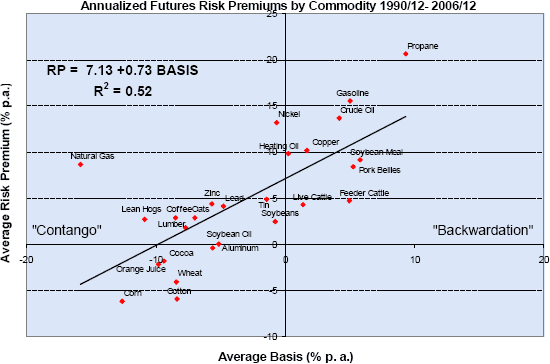We occasionally select for retrospective review an all-time “best selling” research paper from the past few years from the General Financial Markets category of the Social Science Research Network (SSRN). Here we summarize the June 2007 paper entitled “The Fundamentals of Commodity Futures Returns” (download count over 2,500) by Gary Gorton, Fumio Hayashi and Geert Rouwenhorst. Commodity futures are derivative, short-maturity claims on real assets. In this paper, the authors apply the theory of storage to investigate relationships between the physical inventories of these assets and the returns to traders in the associated commodity futures. Using monthly data for over 30 commodity futures and associated physical inventories as available between 1969 and 2006 and data from the weekly Commodity Futures Trading Commission Commitments of Traders (COT) reports, they conclude that:
- Of the 33 commodity futures examined, 26 (21) earn positive arithmetic (geometric) average excess returns. An equally weighted index of these futures earns an average annual excess return of 5.48%.
- The correlations among returns for commodity futures are positive but generally small.
- Commodity futures prices mostly exceed contemporaneous spot prices (are in contango).
- Spot returns, futures basis (percentage difference between the current spot price and current nearest-to-maturity futures price, also called “roll yield” or “roll return”) and past futures returns reflect inventory levels and are informative about commodity futures risk premiums. Specifically, low inventories indicate high commodity futures risk premiums.
- Low commodity inventory levels are associated with futures prices in backwardation (positive roll return), while high inventories are associated with futures prices in contango (negative roll return).
- Over the entire sample period, a portfolio of commodities in backwardation (contango) outperforms (underperforms) an equally weighted index by an average 5.4% (4.8%) per year. A hedge portfolio that is long (short) commodity futures with high (low) basis generates positive returns in 58% of sample months with an average annual return of 10.2%. (See the chart below.)
- A hedge portfolio that is long (short) commodity futures with high (low) momentum also generates positive returns in 58% of sample months with an average annual return of 13.4%. Momentum returns may derive from the slow recovery of commodity inventories from shocks.
- Backwardation and momentum strategy returns stem from selecting commodities subject to high price volatility due to low inventories and thereby earning a premium for bearing volatility risk.
- Aggregate positions of commodity futures traders correlate with both contemporaneous inventories and contemporaneous futures prices. Commercial traders increase short positions after prices spike and when inventories are high. Non-commercial traders increase long positions in commodities with high momentum and, to a lesser extent, positive roll return. However, there is no evidence that net positions (hedging pressure) independently correlate with futures risk premiums.
The following chart, taken from the paper, plots average annualized futures risk premium versus average annualized futures basis (roll return) for individual commodity futures from December 1990 through December 2006. The basis compares futures prices to contemporaneous spot prices, while the risk premium is the difference between futures prices and expected future spot prices. A positive (negative) basis indicates commodity futures in backwardation (contango). A simple linear regression has an R-squared statistic of 0.52, indicating that variation in basis explains 52% of the risk premium. In general, futures prices must exceed contemporaneous spot prices to compensate inventory holders for the cost of storage. Only when inventories are unusually low can the spot price exceed the futures price corrected for storage cost.

In summary, physical inventory levels are the critical determinants of commodity future price variations and returns, intermediating both backwardation (positive roll) returns and momentum returns. After accounting for inventory effects, there is no evidence that the aggregate position of traders (hedging pressure) predicts commodity futures risk premiums.